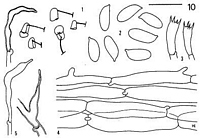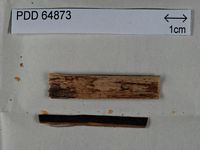|
 Hemimycena reducta Hemimycena reducta
BiostatusPresent in region - Indigenous. Endemic
Images (click to enlarge)
Caption: Hemimycena reducta Horak & Desjardin (PDD, holotype): 1, basidiomes (x2);
2, basidiospores (x2000); 3. basidia (x1000);
4, pileipellis with pilocystidia (x1000);
5, caulocystidia (x1000). | 
Caption: Dried type specimen
Owner: Herb PDD |
Article: Horak, E.; Desjardin, D.E. (1994). Reduced marasmioid and mycenoid agarics from Australasia. Australian Systematic Botany 7: 153-170.
Description: Pileus to 3 mm diam., to 4 mm high, thimble-like
or bell-shaped with a lateral slit, hanging like a street lamp, white, thin-fragile
(almost hyaline), smooth. Lamellae none, hymenophore smooth, white. Stipe to
6 X 0.2 mm, central to eccentric, emerging through the lateral slit, cylindrical,
whitish to transparent-hyaline overall, very fragile, minutely pruinose, dry,
solid, solitary in groups, byssus or basal disc absent. Odour absent. Basidiospores
7-8.5 X 3-3.5 µm, slender elliptic to subcylindric, smooth, hyaline, inamyloid.
Basidia 15-20 X 5-6 µm, tetrasporic, cylindric to subclavate, sterigmata up
to 4 mm long, clamped. Hymenial cystidia absent. Pileipellis a cutis of cylindric
to subfusiform hyphae (3-) 5-16 µm diam., non gelatinous, thin-walled, smooth
(except with few, scattered prong-like projections up to 7 µm long), hyaline,
inamyloid, clamped. Pilocystidia absent. Oleiferous hyphae absent. Stipe tissue
monomitic. Stipe conical hyphae 3-15 µm, cylindric, parallel, non-gelatinous,
thick-walled (up to 2 µm), hyaline, inamyloid, clamped. Caulocystidia scattered,
20-40 µm long, awl-shaped or subfusiform with tapering neck, hyaline, walls
up to 1 µm thick.
Habitat: On rhachis of Dicksonia sp. (tree-fern).
Known from North Island of New Zealand.
Notes: Hemimycena reducta is characterised by forming very small, bell-shaped basidiomes with a smooth
hymenophore and a central to eccentric stipe that emerges through a slit in
the pileus. In addition, the pileipellis is formed from nearly smooth hyphae
(not a Rameales-structure), hymenial cystidia and pilocystidia are lacking,
and caulocystidia are awl-shaped and often setoid. In the field, basidiomes
are suggestive of those of Rimbachia Patouillard (1881) and Calyptella
Quelet (1886), however, a true stipe is not formed by members of either of these
genera. The habit of H. reducta is also suggestive of the genus Cymatella
Patouillard (1889), however, in the latter genus basidiomes develop pigmented
stipes, and have fusoid basidioles and Rameales-type pileipelli.
Hemimycena reducta differs from other Hemimycena species with reduced hymenophore [such
as H. minutissima Desjardin (1991), H. hirsuta (Tode) Singer (1986),
Helotium cyphelloides Redhead (1982), Helotium nebulophilum Redhead
(1982), Helotium circulare (Singer) Redhead (1984)] by the combination
of lacking pilocystidia, lacking numerous diverticula on pileipellis hyphae,
and having tetrasporic basidia.
|